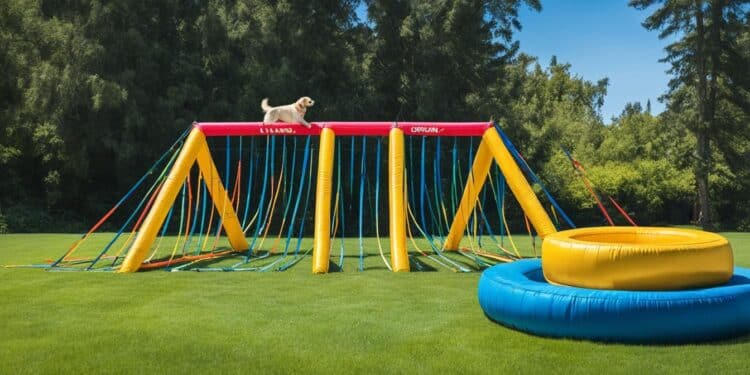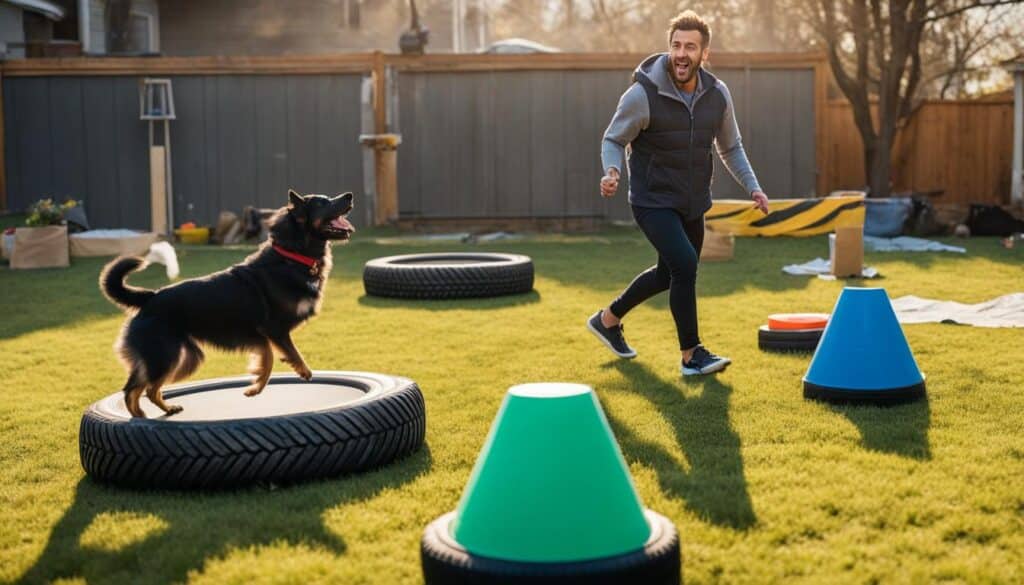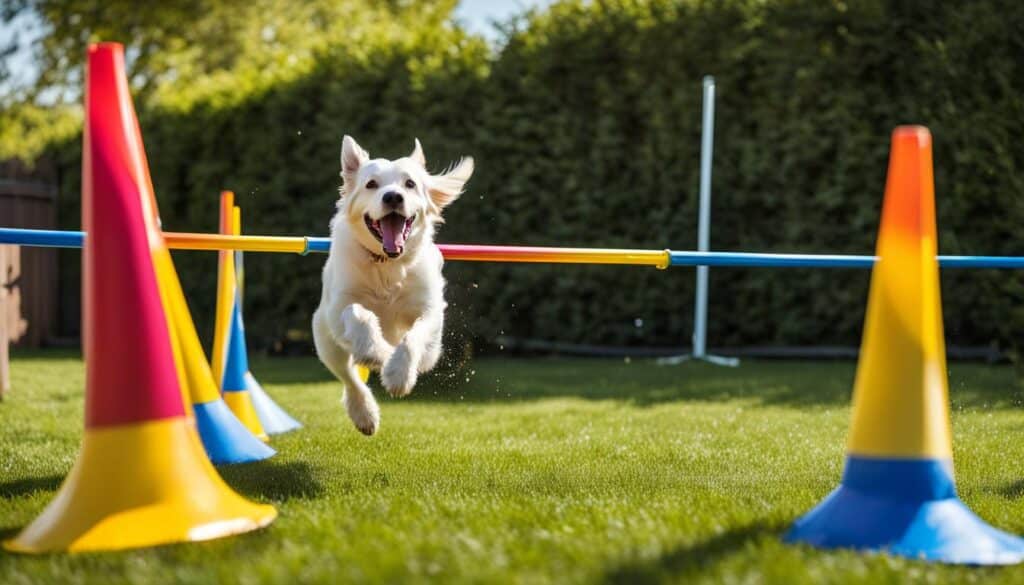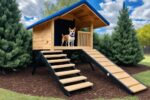DIY Dog Agility Course for Backyard Fun

If you have an active dog, creating a Dog Agility Course in your backyard is a fantastic way to keep them entertained and engaged. Not only does it provide physical exercise, but it also stimulates their minds and fosters a sense of teamwork. Don’t worry, you don’t need to break the bank to get started! With a few simple household items, you can create your own DIY course that will challenge and entertain your furry friend.
Whether you have a large or small outdoor space, you’ll find that building a DIY Dog Agility Course is a fun and rewarding project. Plus, it’s a great way to bond with your dog and strengthen your relationship. So, let’s unleash their inner athlete and embark on this exciting journey together!
Benefits of Dog Agility Training
Agility training offers numerous benefits for both dogs and their owners. It provides a fun and challenging sport for dogs, promoting physical fitness and mental stimulation. It also helps build a strong bond and sense of teamwork between the dog and owner.
Agility training allows dogs to engage in a variety of exercise activities that promote cardiovascular health, muscle development, and overall physical well-being. Running, jumping, weaving through obstacles, and balancing on ramps and see-saws challenge their physical abilities and enhance their coordination and agility.
Moreover, agility training is not only about physical exercise. It also stimulates dogs mentally by requiring them to analyze and respond to various obstacles in real-time. This mental exercise can help prevent boredom and destructive behaviors caused by pent-up energy.
One of the remarkable benefits of dog agility training is its impact on a dog’s confidence. Anxious or timid dogs can gain confidence and overcome their fears by successfully completing each obstacle. When dogs realize they can conquer challenges and overcome obstacles, their self-esteem soars. This boost in confidence can translate to other areas of their lives, leading to a more well-adjusted and contented dog.
Overall, dog agility training provides a holistic approach to exercise and enrichment. It nurtures both the physical and mental well-being of dogs while fostering a deeper connection between dogs and their owners.
Building Basic Obstacles for Your DIY Dog Agility Course
When it comes to creating a DIY dog agility course, it’s essential to start with basic obstacles that are suitable for beginners. The American Kennel Club recommends incorporating jumps, tunnels, and weave poles as fundamental obstacles to introduce your furry friend to this exciting activity.
1. Jumps
Jumps are an excellent starting point for your dog’s agility training, as dogs naturally enjoy jumping. You can easily create a jump obstacle using simple household items. Balance a broomstick across two sturdy buckets or flower pots to create a jumping bar. Ensure the height is appropriate for your dog’s size and ability.
2. Tunnel
A tunnel is another fun and engaging obstacle that you can easily make at home. Use a large cardboard box or drape a blanket over a couple of chairs to create a tunnel-like structure. This provides a challenge for your dog to navigate through and adds excitement to their agility course.
3. Weave Poles
The weave poles offer a more advanced obstacle that requires your dog to navigate through a series of closely spaced poles. To create weave poles, place garden stakes in the ground, creating a straight line. These poles should be positioned close together, allowing your dog to weave in and out of them as they progress through the course.
By incorporating jumps, tunnels, and weave poles into your DIY agility course, you provide a well-rounded and engaging experience for your dog. These basic obstacles are easy to build using common household items, making it accessible and cost-effective for any dog owner.
Building a DIY dog agility course not only provides physical exercise but also mental stimulation and bonding opportunities for both you and your furry companion. With these simple obstacles, your dog will be able to explore their agility skills while having a blast in the process.
Training Tips for Your DIY Dog Agility Course
Training at home is an excellent way to introduce your dog to agility obstacles and develop their skills. By starting with one or two obstacles and gradually increasing the difficulty, you can ensure a positive and successful training experience. Here are some training tips to help you and your dog make the most of your DIY agility course:
1. Start Slow and Build Confidence
Begin with simple obstacles that your dog is comfortable with, such as jumps or tunnels. Allow them to practice these obstacles until they gain confidence and understand what is expected of them. Gradually introduce new obstacles as they progress, always providing positive reinforcement and encouragement.
2. Practice Consistently
Consistency is key when training your dog for agility. Set aside regular training sessions in your backyard and practice specific obstacles or sequences. Dedicate at least 15-20 minutes per session to ensure proper focus and engagement from your dog.
3. Utilize Online Resources and Videos
There are plenty of online resources and training videos available that can guide you through the agility training process. These resources often provide step-by-step instructions, helpful tips, and demonstrations that will assist you in teaching your dog different techniques and maneuvers.
4. Consider Joining a Dog Agility Club
For additional guidance and socialization opportunities, consider joining a dog agility club in your area. These clubs often have experienced trainers who can provide personalized advice and professional tips for improving your dog’s agility skills. Additionally, training in a club setting allows your dog to interact with other dogs, reinforcing their ability to focus and perform in a distracting environment.
5. Attend Training Classes
Attending training classes specifically designed for dog agility can provide structured lessons and expert guidance. These classes often cover a range of agility techniques and offer the opportunity to practice in a controlled and supportive environment. An experienced instructor can provide valuable feedback and adjustments to enhance both your dog’s performance and your training techniques.
6. Compete in Dog Agility Competitions
Once you and your dog feel ready, participating in dog agility competitions can be an exciting way to put your skills to the test. Competitions not only allow you to showcase your dog’s abilities but also provide a valuable learning experience for both of you. You can learn from other handlers, observe different training techniques, and challenge yourself to improve during each competition.
Remember, training at home, with consistent practice and gradual progression, can lead to impressive results in your dog’s agility skills. Whether you train solely at home or supplement your training with dog agility clubs and competitions, the key is to provide a stimulating and enjoyable experience for your furry friend.

Materials and Cost for DIY Dog Agility Course
Building a DIY dog agility course is an affordable and fun project that requires minimal materials. To create jumps and weave poles, you’ll need PVC pipes, which are readily available at hardware stores. It is recommended to use furniture-grade PVC for its durability and longevity. The cost for one agility jump is around $40. To hold the jump bar in place, you’ll also need jump cups that can be easily attached to the PVC pipe. Here is a breakdown of the materials and their estimated costs:
| Materials | Estimated Cost |
|---|---|
| PVC Pipes | $40 |
| Jump Cups | $5 |
Overall, creating your own dog agility course is a cost-effective way to provide fun and exercise for your furry friend. By using PVC pipes and jump cups, you can build durable and customizable agility obstacles to suit your dog’s abilities and training goals.
Step-by-Step Guide to Building a DIY Dog Agility Jump
Building a DIY dog agility jump is a straightforward process. By following a few simple steps, you can create a homemade agility jump using PVC pipes and other basic materials.
Here’s a step-by-step guide to help you build your own dog agility jump:
- Start by cutting the PVC pipes to the appropriate lengths. Measure and mark the desired height for your jump bar. Cut two equal lengths for the vertical supports and two equal lengths for the horizontal bar.
- Connect the pipes using 4-way tee fittings and external end caps to create the jump feet and frame. Insert the vertical supports into the tee fittings on the feet, and connect the horizontal bar to the top of the supports.
- Attach jump cups to the frame at the desired height to hold the jump bar. The jump cups can be easily attached to the PVC pipe by snapping them into place.
- Note: You may also consider adding stripes to the jump bar for better visibility. Use colored electrical tape or paint to create alternating stripes along the length of the bar.
- Once your jump is assembled, place it in your backyard or a suitable area for training. Make sure the jump is stable and secure before allowing your dog to use it.
With these simple assembly instructions, you can create a sturdy and versatile DIY dog agility jump using PVC pipes. Now, your dog can enjoy the thrill of jumping and improve their agility skills right in your own backyard!

Safety Considerations for Dog Agility Training
While engaging in dog agility training can be a fun and exciting activity for both you and your furry friend, it is crucial to prioritize safety. Taking the necessary precautions will help prevent injuries and ensure a positive experience for both dogs and handlers.
Before embarking on agility training, it is highly recommended to consult with a veterinarian to assess your dog’s physical fitness for this type of activity. Their professional guidance will help determine if your dog is ready and capable of participating in agility training without any underlying health issues.
Proper training techniques are essential for injury prevention during agility sessions. It is important to learn and implement the correct handling methods to protect both yourself and your dog. Focus on positive reinforcement and reward-based training to encourage your dog’s cooperation and enthusiasm.
Gradually increasing the difficulty of obstacles is crucial to prevent injuries and allow your dog to build strength and agility over time. Starting with basic obstacles and gradually progressing to more challenging ones will help your dog adapt and master each hurdle.
Rest and hydration are vital during agility training sessions. Providing regular breaks for your dog to rest and hydrate will prevent fatigue and overheating. Make sure to have fresh water available at all times and monitor your dog’s energy levels.
Always prioritize your dog’s safety and well-being. Pay attention to any signs of discomfort or distress during training, and take immediate action if necessary. By keeping these safety considerations in mind, you can create a safe and enjoyable environment for your dog to thrive and reach their full potential in agility training.
Conclusion
Building a DIY dog agility course in your backyard is not only a great way to have fun, but also an opportunity to bond with your furry companion while providing them with mental and physical exercise. By using simple household items and affordable materials like PVC pipes, you can create a beginner’s course that will challenge and entertain your dog for hours.
Whether you choose to train at home or join a dog agility club, participating in this activity will create lasting memories and strengthen the bond between you and your four-legged friend. Imagine the joy on their face as they conquer each obstacle and tackle new challenges in their own backyard playground.
So why wait? Start building your DIY dog agility course today and embark on this exciting journey with your active dog. Get ready for hours of backyard fun, laughter, and a healthier, happier pup. The possibilities are endless, and the rewards are immeasurable!
FAQ
Is dog agility training suitable for all dogs?
Dog agility training can be enjoyed by dogs of all sizes and breeds. However, it is important to consult with a veterinarian to ensure your dog is physically fit for this type of activity.
How can dog agility training benefit my dog?
Dog agility training provides physical exercise, mental stimulation, and helps build confidence in dogs. It also promotes teamwork and strengthens the bond between dogs and their owners.
Can I create a DIY dog agility course at home?
Yes, you can easily build a DIY dog agility course in your backyard using simple household items like buckets, broomsticks, and cardboard boxes.
What are some basic obstacles I can include in my DIY dog agility course?
You can start with simple obstacles like jumps, tunnels, and weave poles. These can be created using items like broomsticks, cardboard boxes, and garden stakes.
How should I train my dog for agility obstacles?
When training at home, start with one or two obstacles and gradually introduce more as your dog gains confidence. Online resources and videos can provide guidance. Joining a dog agility club or attending training classes can also be beneficial.
How much does it cost to build a DIY dog agility course?
Building a DIY dog agility course is cost-effective. The materials, such as PVC pipes and jump cups, can be purchased at a hardware store for around per jump.
How do I build a DIY dog agility jump?
Building a DIY dog agility jump is straightforward. Cut PVC pipes to the appropriate lengths, connect them using fittings, and attach jump cups to hold the jump bar. Stripes can be added for better visibility if desired.
How can I ensure the safety of my dog during agility training?
Before starting agility training, consult with a veterinarian and follow proper training techniques. Gradually increase the difficulty of obstacles, provide rest and hydration for your dog, and prioritize their safety and well-being.





